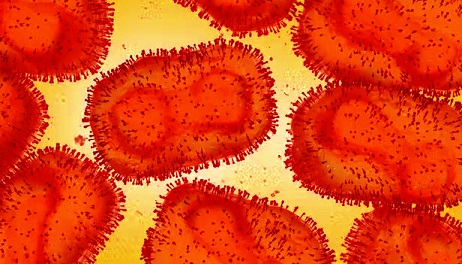Nikhil Prasad Fact checked by:Thailand Medical News Team Dec 30, 2024 3 months, 2 weeks, 5 hours, 40 minutes ago
Medical News: Monkeypox (Mpox), a zoonotic disease caused by the monkeypox virus (MPXV), has emerged as a significant public health challenge. Initially identified in the Democratic Republic of Congo in 1970, monkeypox was once confined to select African countries. However, the virus has recently made its way into non-endemic regions, including Europe, Asia, and the Americas, prompting global health experts to declare it a public health emergency of international concern.
 Triterpenes as Potential Allies Against Monkeypox (Mpox)
Triterpenes as Potential Allies Against Monkeypox (Mpox)
The disease is characterized by flu-like symptoms, including fever, chills, and lymphadenopathy, followed by a rash that evolves into painful pustules. Though monkeypox is typically self-limiting, severe cases occur in vulnerable populations, such as children and immunocompromised individuals. Current prevention strategies include smallpox vaccines, which offer some protection against MPXV. However, vaccine availability is limited, creating an urgent need for alternative therapeutic options.
Novel Approach
Researchers from Kazi Nazrul University, The University of Burdwan, and Syamsundar College in India have turned to triterpenes - naturally occurring phytochemical compounds found in plants - to address this challenge. Triterpenes are known for their antiviral properties against various pathogens, including SARS-CoV-2 and hepatitis viruses. The study covered in this
Medical News report, marks the first in-depth investigation into their potential against monkeypox.
Targeting Key Viral Proteins
The research focuses on three MPXV proteins: A26, D13, and H3. These proteins are vital to the virus’s life cycle. A26 facilitates the virus’s entry into host cells, D13 plays a role in viral morphogenesis, and H3 assists in host cell attachment. By targeting these proteins, researchers hope to disrupt the virus’s ability to infect and replicate within human cells.
Using advanced computational techniques, six triterpenes - asiatic acid (ASA), madecassic acid (MDA), maslinic acid (MSA), betulin (Bet), corosolic acid (CA), and lupeol (Lup) - were analyzed for their binding affinity to these viral proteins.
Molecular docking simulations revealed that MDA and MSA showed the highest potential, forming strong and stable interactions with the target proteins.
Detailed Findings on Triterpenes
-Madecassic Acid (MDA)
MDA demonstrated robust binding to all three proteins, particularly D13. It formed multiple hydrogen bonds and hydrophobic interactions, ensuring a stable protein-ligand complex. The strong binding affinity suggests that MDA can interfere effectively with the virus’s replication and assembly processes.
-Maslinic Acid (MSA)
MSA exhibited similar efficacy, particularly against D13 and H3. Its interactions were strengthened by hydrophobic and alkyl bonds, which play a critical role in stabilizing the protein-ligand compl
ex. This makes MSA another promising candidate for anti-MPXV drug development.
Other Triterpenes
While Bet, CA, and Lup also displayed some inhibitory potential, their binding affinities were less pronounced compared to MDA and MSA. Nevertheless, their inclusion in this study highlights the diverse capabilities of triterpenes in targeting viral proteins.
How Triterpenes Work
Triterpenes work by forming non-covalent bonds with the binding pockets of viral proteins. These interactions disrupt the proteins’ normal functions, inhibiting processes like viral entry, replication, and morphogenesis. For example:
-A26 Protein: Essential for viral entry, its inhibition by MDA and MSA can prevent the virus from infecting new cells.
-D13 Protein: Critical for the formation of stable viral membranes, targeting D13 can halt the assembly of new virions.
-H3 Protein: Responsible for host cell attachment, its inhibition can block the virus’s ability to anchor itself to human cells.
Implications for Drug Development
The findings provide a foundation for developing cost-effective therapies against MPXV. Unlike vaccines, which require significant time and financial investment, repurposing phytochemicals like triterpenes offers a quicker path to creating treatments. Moreover, the natural origin of triterpenes reduces the likelihood of severe side effects, making them an attractive option for widespread use.
Conclusion
This study underscores the potential of triterpenes as antiviral agents against monkeypox. MDA and MSA, in particular, stand out as promising candidates for further research and clinical trials. Their ability to target multiple viral proteins simultaneously enhances their therapeutic potential, offering a cost-effective and efficient solution to a global health crisis.
In summary, harnessing the power of natural compounds like triterpenes could revolutionize how we combat viral diseases, including monkeypox. By leveraging cutting-edge computational techniques and building on the vast reservoir of botanical knowledge, researchers are paving the way for innovative and accessible treatments.
The study findings were published in the peer-reviewed journal: Computational and Structural Biotechnology Reports.
https://www.sciencedirect.com/science/article/pii/S2950363924000279
For the latest Mpox News, keep on logging to Thailand
Medical News.
Read Also:
https://www.thailandmedical.news/news/new-hope-as-study-finds-that-natural-compounds-can-inhibit-monkeypox-mpox-virus
https://www.thailandmedical.news/news/plantagoside-and-narcissoside-from-plantago-lanceolata-can-inhibit-monkeypox-mpox-virus-s-profilin-like-protein-a42r
https://www.thailandmedical.news/articles/monkeypox
